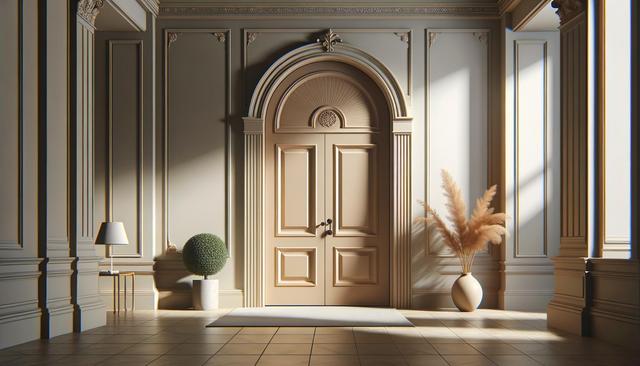Choosing the Right Material for Your Entry Door
When selecting a front entry door, one of the most important decisions is the material. The material you choose has a direct impact on the door’s longevity, energy efficiency, and security. Common materials include steel, fiberglass, and wood, each offering distinct benefits. Steel doors are known for their strength and low maintenance, making them a popular choice for homeowners concerned about security. Fiberglass doors, on the other hand, are resistant to wear and tear from weather and offer a versatile look that can mimic wood grain. For those who value tradition and craftsmanship, wood doors provide a classic aesthetic, although they may require more maintenance.
Each material also affects thermal performance differently. Insulated steel and fiberglass doors often come with a solid core that helps reduce heat loss, a valuable consideration for energy efficiency. When comparing options, it’s essential to balance personal style with practical features like resistance to warping, durability against impact, and maintenance requirements.
Style Options to Complement Your Home
Today’s entry doors are available in a wide variety of styles that can enhance curb appeal while reflecting your personal taste. Whether your home has a modern, traditional, or rustic exterior, there’s a door design to match. Entry doors often feature decorative glass inserts, paneling, and custom hardware that add a unique touch. Homeowners can also choose from a broad color palette or opt for a stain that enhances the appearance of wood grain or composite materials.
Popular style options include:
- Full or partial glass panels for natural light
- Craftsman-style doors with clean lines and square panels
- Arch-top designs for a more classic or Mediterranean look
- Contemporary flush doors with minimalist hardware
In addition to visual appeal, consider how the design of the door integrates with your home’s existing architecture and color scheme. A well-chosen front door can serve as a welcoming focal point for your entryway.
Security Features That Matter
Security is a key function of any entry door, and modern designs incorporate features that go beyond just a solid frame. Materials like steel naturally offer higher resistance to forced entry, but additional reinforcements can further enhance safety. Look for doors with multi-point locking systems, reinforced strike plates, and quality deadbolts. Fiberglass and wood doors can also be secure when properly installed and paired with these enhancements.
Other important security considerations include:
- Peepholes or wide-angle viewers
- Smart locks and keyless entry systems
- Impact-resistant glass on doors with windows
- Heavy-duty hinges with non-removable pins
Proper installation is just as crucial as the materials and hardware. A poorly installed door can negate even the most advanced security features, so professional installation is recommended for optimal performance.
Energy Efficiency and Insulation Value
Energy efficiency is an increasingly important factor for homeowners, especially in climates with extreme temperatures. Entry doors contribute to the thermal envelope of a home, and choosing an energy-efficient model can help reduce heating and cooling costs. Look for doors with an Energy Star rating and features such as insulated cores, weatherstripping, and tight-fitting frames.
Fiberglass and steel doors with foam cores tend to offer higher R-values, a measure of thermal resistance. Wood doors, while naturally insulating, may require additional weatherproofing treatments to perform similarly. Glazed doors or those with glass inserts should feature double or triple-pane glass with low-emissivity (Low-E) coatings to minimize heat loss and UV transmission.
Benefits of an energy-efficient entry door include:
- Lower monthly utility bills
- Improved indoor comfort year-round
- Reduced environmental impact
- Potential increase in home resale value
Combining insulation with durable weather seals ensures your front door remains efficient over time, even with frequent use.
Maintenance and Long-Term Performance
While aesthetics and security are crucial, long-term performance and maintenance are equally important when choosing an entry door. Different materials require varying levels of upkeep. Steel doors typically need only occasional cleaning and repainting if scratched. Fiberglass doors resist dents and weather-related wear, making them low-maintenance. Wood doors, though beautiful, often need regular sealing or painting to prevent warping, cracking, or moisture damage.
To keep your entry door looking and functioning well over time, consider these maintenance tips:
- Clean the surface with mild soap and water periodically
- Inspect weatherstripping and seals for damage or wear
- Lubricate hinges and locks annually
- Touch up paint or finish to prevent rust or moisture penetration
Choosing a door with durable finishes and high-quality hardware can also reduce maintenance needs. Some manufacturers offer factory-applied coatings that resist UV rays and fading, which can extend the life of your door’s appearance.
Conclusion: Investing in a Functional and Stylish Entryway
Exploring front door options is more than a matter of aesthetics – it’s also about making smart decisions for your home’s security, efficiency, and long-term value. With the variety of materials, styles, and features available today, homeowners can select an entry door that enhances curb appeal while providing reliable protection and insulation. By considering key factors like durability, energy performance, and maintenance needs, you can find a solution that fits both your lifestyle and your architectural preferences. A thoughtfully chosen entry door not only welcomes guests but also contributes to the comfort and safety of your entire household.




Leave a Reply